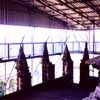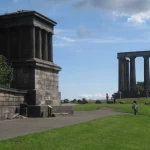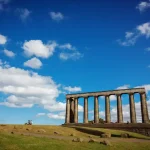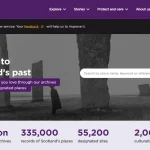Rosslyn Chapel Conservation, Historic Scottish Building Carvings, Architect, Project, Design
Rosslyn Chapel Restoration Architecture
Historic Church in Roslin, south of Edinburgh, Midlothian, Scotland
22 Mar 2007
The Heritage Lottery Fund and Historic Scotland join forces to save the world-famous Rosslyn carvings
Rosslyn Carvings Restoration
It was announced today that the 15th century chapel that captivates visitors from across the world with its fascinating mysteries and enigmas is to be carefully conserved thanks to grants totalling over £7million. , which is a worldwide attraction and has featured in Dan Brown’s Da Vinci Code, has been awarded a Stage One pass* for a grant of £4,500,000 from the Heritage Lottery Fund and £2,697,892 from Historic Scotland.
Described as a book in stone, Rosslyn Chapel is renowned for its intricate carvings with symbols of the Knights Templar, Christianity, Freemasonry and mythology, each inspiring theories on the secrets they hold. However, these carvings are now extremely fragile and at serious risk of loss. The building itself, which dates back to 1446 is also in a seriously poor condition as a result of age and exposure to the elements.
After ten years of detailed investigation and planning, an extensive five-year programme of repair has now been established. It will include conserving and protecting the stonework, repairing the stained and leaded glass and restoring the Victorian baptistry. The temporary tin roof, which has protected the chapel for the last ten years to let the original roof and walls dry out – a project also funded by the Heritage Lottery Fund and Historic Scotland – will be removed. Working with the Scottish Lime Centre, the project will provide unique opportunities for training in heritage conservation skills.
Since featuring as the home of the Holy Grail in Dan Brown’s international bestseller, The Da Vinci Code, Rosslyn Chapel has seen its visitor numbers increase from 30,000 a year in 2000 to 120,000 visitors in 2006. As such current visitor facilities, designed for a maximum capacity of 35,000 are completely inadequate.
The Heritage Lottery fund grant will help fund the development of the existing visitor facilities to provide a new reception with an interpretative timeline, exhibition space, flexible education space, café, shop and toilets. Designed by Page and Park, the new building will improve circulation and provide interpretation of the chapel for the first time.
Patricia Ferguson, Minister for Tourism, Culture and Sport announced the Historic Scotland funding for the project and welcomed the partnership working that characterises the scheme.
“Rosslyn Chapel has gained world-wide fame through the success of the Da Vinci Code. What many do not realise is that the chapel has in fact enjoyed international acclaim as one of Scotland’s most impressive and important buildings for hundreds of years. The protection it receives from being listed and scheduled has helped to ensure that we have this national treasure still.
It is through partnership working between Historic Scotland, Heritage Lottery Fund and the Rosslyn Chapel Trust that visitors to this site, no matter how far they have travelled, will continue to be impressed and inspired. The dedication that was displayed in the creation of this impressive chapel is being reflected in the efforts to conserve it, and we can be sure we will pass on this invaluable legacy in the condition such a monument deserves.”
Brian Lang, Chair of the Heritage Lottery Fund’s Scotland Committee, said:
“The spectacular architecture of Rosslyn Chapel has captivated hundreds of thousands of visitors from all over the world. The craftsmanship of its stonework is only surpassed by the mysteries its designs hold. The Heritage Lottery Fund is delighted to be able to support the conservation of this iconic Scottish building in a project that allows visitors to explore, enjoy and learn about a remarkable piece of Scotland’s heritage without detriment to its incredible medieval fabric.”
Andrew Russell, Managing Trustee of the Rosslyn Chapel Trust, commented:
“These awards mark a vital milestone in the history of the Trust, and of the Chapel as a whole. When our plans to conserve the fabric of the building and improve our visitor facilities are complete, we expect to have invested over £13m and to be providing a greatly enhanced visitor experience to a much broader audience.
We look forward to renewing the partnership with the Heritage Lottery Fund and to continuing our work alongside Historic Scotland, Midlothian Council and our team of professional advisers, all of whom have worked hard in co-operation with our staff to bring our proposals to this important stage.”
*A ‘Stage One Pass’ means that money has been earmarked by the award body, in this case the Heritage Lottery Fund and Historic Scotland for the project in question. Competition at this stage is tough, and while a Stage One Pass does not guarantee funding, it is an indication of positive support, and money for the scheme is set aside. The applicant can then progress to Stage Two and submit a further, fully developed application to secure the full grant. On occasion, at Stage One, funding will also be awarded towards the development of the scheme.
Rosslyn Chapel, set in Roslin Glen near to Rosslyn Castle, was founded in 1446 by Sir William St Clair and took forty years to build. It is part of a much larger building which was planned but never completed.
A previous restoration in1871 was inspired by Queen Victoria who was seduced by the Chapel
The carvings in the Chapel are the focus of much speculation. For example, carvings of what appear to be cacti and Indian corn, native to North America, appear in this Scottish building although Columbus’ does not discover America till 100 years later.
Another focus of interest is the Apprentice Pillar. Legend has it that while the mason was in Rome studying the original inspiration for the pillar, the apprentice completed the complicated task of carving the column. In a fit of jealous rage the mason strikes the apprentice with his mallet, killing him.
The Chapel has attracted a host of illustrious visitors over the years including Mary Queen of Scots, Queen Victoria, Prince Albert, King George and Queen Mary, Robert Burns, Alexander Naysmith, William and Dorothy Wordsworth, Sir Walter Scott, Samuel Johnson, JMW Turner, John Ruskin, David Octavius Hill, the Queen and Prince Charles.
Today’s award follows last week’s announcement when HLF committed £1.4million to restoring nine other churches across Scotland. This scheme is run in partnership with Historic Scotland.
The Heritage Lottery Fund (HLF) enables communities to celebrate, look after and learn more about our diverse heritage. From our great museums and historic buildings to local parks and beauty spots or recording and celebrating traditions, customs and history, HLF grants open up our nation’s heritage for everyone to enjoy. To date it has invested over £450million in Scotland’s heritage.
Historic Scotland is an executive agency of the Scottish Executive and is fully accountable to Scottish Ministers and through them to the Scottish Parliament.
Historic Scotland was established in 1991 and since this time has awarded well in excess of £150 million in grants for the repair, maintenance and regeneration of the historic environment. This money has attracted match-funding in excess of £400 million.
Rosslyn Chapel : history + photographs
Roslin Church, Roslin, south of Edinburgh, Midlothian
just south-east of Roslin village, off B7006, by Roslin Glen

roof image © Adrian Welch
Rosslyn Chapel Phase Two architects – Simpson & Brown
Comments / photos for the Rosslyn Chapel Restoration south of Edinburgh page welcome



